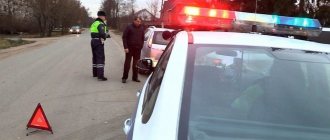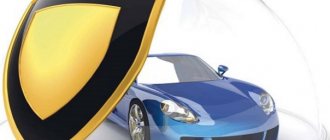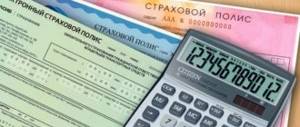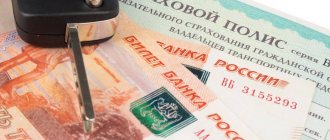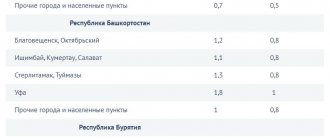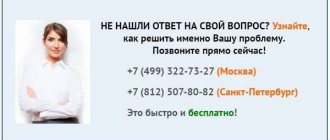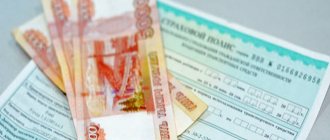What is the Unified Methodology for Calculating Damage?
The Unified Methodology for Calculation of Damage (UMRU) is a special method with which you can calculate the amount of insurance compensation under compulsory motor liability insurance.
In fact, EMRU is a set of formulas.
The unified calculation methodology is regulated by the following documents:
- Federal Law No. 432-P . It is the main regulatory document in accordance with which the amount of monetary compensation is calculated.
- Federal Law No. 433-P . It is an additional regulatory document that regulates the rules for conducting an independent examination, with the help of which it is possible to assess the amount of damage and establish some details of the accident.
- BCZ . It is an electronic database that stores information about the cost of certain spare parts for most vehicles.
The draft laws were developed by the Ministry of Transport, the Central Bank and the Russian Union of Auto Insurers (RUA). Before the introduction of ERMU, there were more than 5 recommended state methods with which it was possible to determine the amount of damage.
The problem was that these techniques did not fit well with each other, which led to confusion. Another problem was that different methods gave different results, and the size of the recommended payments when using different methods could differ by 2-3 times .
Because of this confusion, many dissatisfied car owners sued the insurance company, and in 2013, before the law was adopted, the number of such lawsuits was more than 600 thousand.
The adoption of EMRU allowed us to solve many problems:
- Reducing the burden on the judiciary.
- Increasing the level of transparency between insurance companies and motorists.
- Unification of calculations.
- Stabilization of the economic model of compulsory motor liability insurance.
- Increasing the reliability of insurance companies.
Calculation of the cost of spare parts taking into account wear and tear
Despite this, there is positive news for motorists: RSA participants promise that average payments under MTPL will be increased. In addition, 2 important provisions of the Bank of Russia are now in effect: approving a unified method for determining the amount of costs for car repairs, and the rules for performing an independent technical examination.
Due to this, experts will not be able to perform large maneuvers in relation to cost adjustments. Payments under compulsory motor liability insurance are becoming fairer, and insurers are increasingly less likely to file a claim in court in order to achieve a fair payment.
Today, to calculate the cost of spare parts taking into account wear and tear, both spare parts, consumables, and the work themselves are taken into account. Previously, the latter were not included in the cost of compensation payments; drivers paid out of their own pockets.
Good to know! Also, the resulting calculation amount taking into account wear and tear cannot exceed 50% (previously the figure was up to 80%). To determine it, there are 2 formulas: for the car itself and separately for the tires. This division is due to the fact that tires are considered an expensive part of the car, and they wear out much faster than even “consumables”.
With this method, experts determine both the cause of the accident and the circumstances. In this case, it is determined whether the damage occurred during the incident, or whether it happened before it.
Method structure
EMRU is a document with which you can calculate the cost of insurance compensation. The EMRU contains the following information - definition of basic terms, calculation algorithms, formulas for calculations, reference materials, rules for drawing up expert reports, and so on. Using this information, you can accurately determine the amount of insurance payment for repairs.
The unified methodology for calculating damage contains information about all the main cars that can be found in the Russian Federation (the total number of car brands is more than 67, and the list itself is periodically updated).
It should also be remembered that EMRU can only be used if the client of the insurance company is an individual.
The methodology has the following structure:
- 7 main chapters , which contain basic information on the calculation of insurance compensation under compulsory motor liability insurance.
- 10 applications that contain some additional information (correction factors, a list of parts for which a zero wear value is set, the average annual mileage of cars, and so on).
- There is also a special electronic database that contains information on the average market cost of parts. This database is called BCZ.
| Type | Number | Short name | Information |
| Head of the Basic Law | 1 | Procedure for determining vehicle damage | Contains general information about EMRU. It is also indicated here that EMRU was created so that with its help it would be possible to calculate the amount of insurance compensation for damage to any vehicle. It also stipulates some basic concepts (evidence, vehicle examination, examination results) that are used to calculate insurance payments. Information is also indicated here that all examinations are divided into primary (carried out by an emergency commissioner or an insurer’s technician) and additional (carried out by forensic and independent experts). |
| 2 | Investigation of the circumstances of the accident | This chapter discusses the issue of studying the circumstances of an accident. The circumstances of the accident are studied with the help of special examinations, with the help of which it is possible to establish the key details of the accident (based on this information, in the future it is possible to establish the culprit of the accident, the degree of culpability, the type of violations that led to the accident, the amount of damage caused, and so on). Typically, two examinations are carried out to investigate the circumstances of the accident. The first examination is an expert-comparative analysis of the documentation that was drawn up after the accident. The second examination is a scientific expert analysis of an accident, with the help of which it is possible to establish the nature and type of damage caused; Based on this data, a computer model can be created that can be used to identify the culprit of the accident. If one of the parties does not agree with the conclusions of previous examinations, it can conduct an additional examination to clarify some details that may be important when considering the case. | |
| 3 | Determining the level of repair costs | Contains a number of algorithms that can be used to calculate the total cost of vehicle repairs. The following expense items are discussed here: the purchase of new auto parts (engine, headlights, bumper, etc.), the purchase of materials (paint, primer, abrasives, and so on) and the services of technicians. | |
| 4 | Determining wear levels when purchasing new parts | This chapter contains information on which you can calculate the wear of old parts. The fact is that many parts deteriorate over time, so when determining the level of compensation, the residual cost of the old part (taking into account wear and tear) should be subtracted from the full cost of each new part. | |
| 5 | Determining the cost of surviving parts if the vehicle is destroyed | This chapter describes a methodology with which you can calculate the cost of some spare parts, provided that the vehicle is completely destroyed (and there is the possibility of reusing these undamaged parts). The fact is that the damage caused may be so severe that the car will be almost impossible to repair, but some parts may be serviceable. Based on the data provided in this chapter, the cost of these serviceable spare parts can be calculated. | |
| 6 | Determining the value of a vehicle before damage | Contains information on how to use a methodology to calculate the pre-accident value of a vehicle. With the help of this information, you can understand whether it makes sense to restore the vehicle at all. The fact is that sometimes the damage can be so severe that repairing the vehicle does not make sense (for example, the value of the car before the accident may be much lower than the cost of repair). This chapter also specifies a method for calculating the average market value of a new car that is similar to a damaged one. If it turns out that a new car costs much less than repairing a damaged car, then the person is simply given money to buy a new vehicle (after all, in most cases it is quite difficult to calculate the cost of a car before an accident). | |
| 7 | The procedure for approving reference books for calculating the average cost of damaged parts | This chapter contains a list of sources that can help a technician or insurer estimate the cost of new parts. The fact is that when calculating damage, many parameters are used that can change (for example, the market value of parts). Some regulations of the Central Bank, an electronic database of spare parts, price standards and some other documents that do not contradict the EMRU are used as regulatory documents containing the necessary information. | |
| Appendix to the law | 1 | Photographing an accident and a damaged car | Contains information on how and in what cases it is necessary to record the consequences of an accident on photographic or video equipment. This information will be useful both in the case of drawing up a standard protocol with the involvement of traffic police officers, and in the case of drawing up a European protocol without the participation of traffic police officers. This information may also be useful in the event of litigation. |
| 2 | Typical vehicle damage | Contains information that can significantly simplify the procedure for classifying damage caused. This application also states that there are a total of 32 characteristic damages. | |
| 3 | Costs for restoring the body of some vehicles | This paragraph contains information on the basis of which you can calculate the cost of repairing non-metallic bodies of some vehicles. The fact is that the body of some foreign and domestic cars is made not of metal, but of some other materials (for example, special plastic), so an additional method is needed to calculate the repair of such a body. | |
| 4 | Commodity markets and boundaries of economic regions | Contains information about which economic regions certain areas belong to (13 regions in total). The fact is that the average market cost of parts is calculated taking into account the economic region (after all, for example, the price of a part in St. Petersburg may differ significantly from the price of the same part in Vladivostok). | |
| 5 | Size of correction factors for determining the degree of wear | When calculating the degree of wear, 2 special coefficients are used (depending on the type and brand of the vehicle). In this application you can find out the size of these coefficients in order to correctly calculate the degree of wear. | |
| 6 | Size of correction factors for determining the degree of wear of very old parts | In some cases, the values of the 2 correction factors (used to calculate the degree of wear) can be reduced. This annex provides information about the specific cases in which this may occur; The degree of reduction of these correction factors is also indicated here. | |
| 7 | List of parts for which wear value is set to zero | For some damaged parts, the wear value is set to zero. This appendix provides a list of these parts (brake discs, steering wheels, tie rod ends, etc.). | |
| 8 | Directory of average annual vehicle mileage (including regions) | When calculating the cost of repairs, the vehicle's mileage is also taken into account. In this application you can find out the average annual mileage of vehicles (taking into account the type of vehicle and region of residence). | |
| 9 | Reducing factor K, with which you can take into account the operating time of the vehicle | The cost of insurance payment may be slightly reduced depending on how long the vehicle is in use. This annex specifies the size of this reduction factor (the size of the factor depends on the type of vehicle and age of use). | |
| 10 | Additional coefficient K, which can be used to take into account the nature of mechanical damage | The cost of insurance payment may be changed depending on the nature of mechanical damage. This annex indicates the size of the correction factor, and the factor itself depends on the degree of mechanical damage. |
Calculator
Every car enthusiast in 2021 can independently find out the information through the RSA portal. To obtain information, you do not need to pay for RSA services or register. All information is available on the RSA portal, in the “OSAGO” section at the link https://prices.autoins.ru/priceAutoParts/.
Average cost of spare parts
To receive the requested information, you will need to select the date of application and the economic region of the injured motorist. Additionally, you should select the vehicle data and indicate the number of the spare part for which the calculation is being made.
Attention! You can add a maximum of three spare parts. If there are more of them, then you need to create another request.
After entering all the data, select “Send request” and receive an instant report. If necessary, the resulting report can be saved in the system. To do this, select “Save query result” and save your personal report number.
Average cost per standard hour of work
The cost of a standard hour is determined for each vehicle. To obtain information, you will need to enter the appropriate section of the RSA portal and select:
- date of application;
- the region in which the repair work will be carried out;
- vehicle brand;
- vehicle type: passenger car, truck, etc.
After selecting the conditions, send a request and receive an offer, which you can save if necessary.
The resulting report will indicate the cost of a standard hour according to the standards of the Central Bank and RSA.
Vehicle inspection report after an accident
After an accident, it is necessary to draw up a vehicle inspection report (usually this document is drawn up by experts with the participation of people who were involved in the accident).
The vehicle inspection report must include the following information:
- Reason for inspecting the vehicle (in our case it will be an accident).
- The exact start and end date of the vehicle inspection.
- The exact address . If the accident occurred near a house - the street name and house number, if the accident occurred at an intersection - street names, if the accident occurred far from any populated areas - the name of the highway, kilometer number and direction of travel.
- Full information about the owner , as well as information about the person who was driving at the time of the accident (after all, in the general case, the driver may not be the owner of the car, but some other person, for example, a friend of the car owner).
- Information about the vehicle - equipment, start-up, mileage, and so on.
- Information about damage that occurred before the accident . It is necessary to indicate not only all old damage, but also indicate the type of damage, their location, and so on. If repairs were made or spare parts were changed, this fact must also be reflected in the report.
- Information about damage that occurred as a result of an accident . It is necessary to indicate not only all existing damage, but also indicate the type of damage, their location, and so on.
- If any part was taken for analysis to conduct an additional examination, this fact must be reflected in the report.
- The current condition of the car should also be indicated in the report. If the car was evacuated , information about where and how the vehicle was evacuated should be reflected in the report.
Unification of prices
To calculate damages in 2021 and calculate the amount of compensation for damage from road accidents, all insurance organizations rely on unified sources.
This means that the driver does not need to ask for an additional examination to understand how correctly the insurer made his own calculations.
There are several factors on which the amount of compensation directly depends. These include:
- date when the accident occurred;
- car make;
- region;
- number of the part that directly received the damage.
There are often situations where the results may not be reflected entirely correctly. This happens when one of the points noted above is changed. This usually refers to the part number.
Important: the appraiser may accidentally fail to include any damaged part in the report, which, of course, will affect the total amount. To avoid unpleasant situations, you should pay attention to the work of the appraiser and what he puts into his report.
Rules for conducting examination of calculations using RSA
The unified methodology for calculating damage contains special rules that regulate the conduct of special examinations, with the help of which the amount of monetary compensation can be determined.
EMRU requires experts to meet the following requirements:
- They must have higher technical education.
- They must undergo special expert technical courses. At the end they must pass the exam successfully.
- They must take advanced training courses at least once every 5 years.
- The minimum professional experience is 12 months.
- After receiving a license to conduct an examination, information about the expert is entered into a special list of auto expert technicians. This list can be found on the RSA website . From this register you can find out the following information about the expert - full name, city, legal status, terms of accreditation, contact details, and so on.
Can PCA replace expert assessment?
As mentioned earlier, the expert assessment cannot be replaced by the present value in the RCA, since the final cost depends on the region, assessment of the condition of the part (which the reference book cannot produce), the scope of work and other factors. The directory only provides indicative information that is close to reality.
The RSA portal is a useful resource for car owners, since it is there that they will find a lot of useful information.
Note! Estimating the approximate cost of spare parts gives an idea of the prices on the market, which you need to approximately focus on, and accordingly helps to avoid ordering work from scammers and those who unreasonably inflate the cost several times over. For the best effect, you should consult with several specialists.
Didn't find the answer to your question? Find out how to solve exactly your problem - call right now: +7 (Moscow) +7 (812) 309-53-42 (St. Petersburg) It's fast and free!
Setting the amount of payments - the basic formula
The unified methodology for calculating damage contains information on how to correctly calculate the amount of insurance compensation.
The following formula is used for calculations:
- RK = SR + SM + SD.
- RK is the total amount of compensation.
- CP is the cost of repair.
- CM is the cost of materials.
- CD is the cost of parts that need to be replaced.
- When calculating these indicators, the average market cost of parts, materials and repair work is taken into account. The maximum degree of deviation from the average market value can be no more than 10% .
- When calculating the cost of work (CP) and materials (CM), the date and region of the accident are taken into account.
- Calculation of CP and SM occurs on the basis of the standards specified in Appendix No. 3.
- Only those damages caused by road accidents are taken into account . If, for example, someone scratched a car before an accident, then the insurance company will not give money to paint over the scratch.
- It should also be remembered that when calculating the cost of parts (CP), wear should be taken into account. To do this, it is necessary to calculate the correction factor using a special complex formula; after this, you need to subtract this coefficient from unity, and the resulting result should be multiplied by the SD parameter.
It should be understood that the correction factor will always be less than one, so the full market value of the damaged part will not be returned to you.
And this is fair - after all, over time, many parts wear out, and if you are in an accident, the insurance company must only compensate for the market value of the old part.
- If the total amount of compensation exceeds the cost of a new car of the same make and model, then the insurance company will issue money not for repairs, but for the purchase of a new car . Often this approach is used when there is so much damage that it is much cheaper to buy a new car than to repair the old one.
How to calculate the extent of damage?
Calculation of the amount of damage in monetary terms is carried out on the basis of several actions that are determined by a set of documents that were legislated in Order No. 315 of the Ministry of Justice, in Order No. 714 of the Ministry of Health and Social Development and in Order No. 124 of the Ministry of Transport. These actions include:
- Vehicle inspection by a certified expert. This action is divided into:
- Preparing the car for expert inspection.
Conducting an initial inspection.
- Inspection of damage sustained by the car body.
- Inspection of damage sustained by the machine frame.
- Preliminary technical conclusions on methods for restoring a vehicle.
- Studying available information about a traffic accident. This action is intended to monitor the conclusions made by the traffic police officers, as well as to determine the real causes of all damage received by the car. This work includes:
- Analysis based on expert comparison of available facts about road accidents.
- Computer modeling of the road situation in which the accident occurred.
- Analysis of the incident by highly specialized experts (only in cases where other analyzes could not provide a reliable answer).
- Determination of the list of works for restoration and repair of the machine. This conclusion is made based on 5 parameters:
- Costs for car parts.
Costs for consumables that will be required when replacing car parts.
- Labor costs for automobile repair technicians.
- Degree of wear of replaced spare parts.
- The cost of spare parts suitable for further use (calculated only for the complete destruction of the vehicle).
- Calculation of the market price of a car before an accident. This appraisal work is done to compare the cost of repairs with the cost of the entire car before the accident. If the cost of repairs is higher, then to avoid additional financial losses, the insurer may recognize the car as unsuitable for restoration and pay compensation equal to the cost of the car before the accident, minus the remaining parts.
All the provisions described above are associated with a huge amount of technical information. It is impossible for an ordinary driver without specialized education to understand all the nuances.
Prices for all the actions described above are taken from a single RCA database, which will be discussed in detail in a separate section of this article.
How to calculate damage under compulsory motor liability insurance
Let's try to calculate the amount of damage ourselves:
- Let us have a car CHERY TIGGO (T11). Let's assume that the car was released in 2012. Its mileage was 70 thousand kilometers.
- In March 2021, an accident occurred.
- Let's first calculate the degree of wear . To do this, you can use a special complex formula; You can also use a special online calculator. Regardless of the calculation method, we will get a wear rate of 0.35 (or 35%).
- Let us remind you that the amount of compensation is calculated according to the following formula : amount of compensation (RK) = cost of materials (CM) + cost of repairs (SR) + cost of parts (SD).
- Let's first calculate the SD parameter (cost of parts). Suppose we should buy a bumper, a right headlight and a mount for the right headlight. To do this, let's go to several sites and find out how much the same parts will cost on different sites (we will visit 3 sites). After this, you should calculate the arithmetic average (this will be the average market value). Let the bumper cost 3,600, 3,400 and 3,200 rubles on different sites - then the arithmetic average will be 3,400 rubles. Using the same scheme, we will calculate the cost of the headlight and headlight mount - let their average market price be 3,000 rubles and 800 rubles, respectively. Now let's add up these three numbers - we get 7,200 rubles. Now let's calculate the cost of parts taking into account wear: (1 - 0.35) * 7,200 = 4,680 rubles.
- Let us now calculate the CP parameter (repair cost). Let us only need to repair the wheel arch and carry out wheel balancing. Let the average market price of a standard hour in cases 1 and 2 be 1,000 rubles each. Now let’s open Appendix No. 3 - it states that the standard is 3.0 and 0.1 in the first and second cases, respectively. Let's calculate the CP: CP = 3.0 * 1.000 + 0.1 * 1.000 = 3.100 rubles.
- Now let's calculate the CM parameter (cost of materials). Let's say we should paint the new bumper and bumper mount. Let's assume that the average market price for a standard hour is 1,200 and 500 rubles, respectively. Let's open the application - it states that the standard is 1.0 and 0.4, respectively. Let's calculate CM: CM = 1.0 * 1.200 + 0.4 * 500 = 1.200 + 200 = 1.400 rubles.
- Now we have all the data. Let us now calculate the amount of the insurance payment : RK = SM + SR + SD = 1,400 + 3,100 + 4,680 = 9,180 rubles.
What to pay attention to
When contacting an auto expert, you should take into account that he must have:
- special knowledge and skills;
- appraiser diploma;
- status of an expert technician included in the register of the Ministry of Justice.
In addition, when contacting an independent expert, remember that he must draw up an agreement with you on the provision of assessment services. Payment for services under the contract must be confirmed by a cash receipt or other financial document confirming your payment for the expert’s services.
In addition to damage from an accident, you can ask an expert technician to calculate LCV (Loss of Commodity Value). Remember, TCB is not voluntarily reimbursed by RSA. However, in court this insurance dispute can be resolved in your favor.
Formula
In addition to the PCA calculator, the calculation can be performed using the formula given in a unified methodology, mandatory for all insurers:
Tsr = Zpr + Zm + Zzch, where
- CR – total cost of repair;
- Zpr – costs of repair work;
- Zm – materials for restoring spare parts;
- Ззч – cost of spare parts.
The components of the above formula are calculated separately.
To calculate the cost of spare parts, the formula is used:
Ззч = Σk×Sд×(1 – И/100), where
- k – number of identical spare parts to be replaced;
- Sд – price of one spare part;
- And – the degree of wear of the spare part.
The cost of materials is calculated using the formula:
Zm = ΣSm×Nm×K, where
- Sm – unit price of the material;
- Nm – material rationing indicator;
- K – spare parts restored using the material.
A special reference book is used for pricing repair work.
Reasons for refusal to pay insurance by RSA authorities
RSA often denies compensation payments on flimsy pretexts. For example, such as “the MTPL insurance policy was not included in the database” or “the MTPL insurance policy was stolen from the insurance company.”
In this case, even if you have collected a complete and correct package of documents, and also calculated the damage from the accident from an independent expert technician, there are two scenarios for the development of events.
- 1. If the MTPL policy was issued before it was reported to the police as stolen, then you are entitled to a compensation payment from RSA and RSA’s refusal is illegal.
- 2. If the OSAGO policy was issued after it was reported to the police as stolen, then, unfortunately, the refusal cannot be challenged in court.
How to find out the average cost of auto parts?
To clarify the average market cost of parts using the PCA database, the policyholder must provide the following information:
- Date of the traffic accident.
- Economic region of location from the list.
- Model of the insured vehicle.
- The number of the spare part to be replaced from the catalog.
The part number can be found in the electronic catalog on the car manufacturer's website. You need to know the VIN number of the vehicle.
There are many useful publications on our website from which you will learn how to:
- the price of the electronic policy is formed;
- establish the amount of compensation taking into account depreciation;
- calculate vehicle insurance under compulsory motor liability insurance using an online calculator;
- establish the amount of the penalty if the insurance company does not pay on time.
Loss determination table
EMRU is an extensive document, which includes 7 main chapters and 10 appendices. The methodology document looks like this:
| № | Chapter Contents |
| 1 | The procedure for determining the nature of damage. |
| 2 | Determination of the circumstances that led to the accident. |
| 3 | Cost calculation:
|
| 4 | Calculation of the amount of wear of parts to be replaced. |
| 5 | Calculation of the cost of suitable remains if the vehicle is completely beyond repair. |
| 6 | Determination of data from the price list of the car before damage occurs. |
| 7 | Approval of directories taking into account economic regions |
Applications:
| № | Content |
| 1 | About photographing objects. |
| 2 | About types of characteristics and definitions of damage. |
| 3 | About the volume of labor costs when determining the geometry of the body. |
| 4 | On the characteristics of economic regions. |
| 5 | About coefficients affecting wear. Delta L and T. |
| 6 | About coefficients when calculating especially worn elements. |
| 7 | About zero wear of individual technical components. |
| 8 | Guide to average annual vehicle mileage. |
| 9 | About the temporary reduction factor K. |
| 10 | On the technical coefficient of mechanical damage K. |
When calculating damage in the event of complete destruction of a car, the following are taken into account:
- have not been previously repaired;
- those that can be equipped with remanufactured parts.
The amount paid to the policyholder for damage to the vehicle is determined taking into account certain factors:
- The percentage of wear and tear on parts of the car.
- The location of the vehicle relative to the economic region.
- Time interval of a traffic accident.
- Cause of damage.
- Vehicle model.
Using an online calculator, the approximate cost of damage is calculated , but the final verdict is made by an evaluation expert commission.
Working with the service on the website
Checking and adjusting thermal clearances in the Renault Logan valve drive
Before you start working with the service for calculating civil insurance compensation using the new method, you should make sure that the computer software is suitable for this. The following browsers are suitable for correct work with the database:
- Internet Explorer version 9.0 and later.
- Mozilla Firefix version 31.0 and later.
- Chrome version 36.0 and later.
If the software is suitable, you need to check the availability of the databases:
- Log in to a suitable browser.
- Go to the RSA website.
- Go to the OSAGO section and click on the link to check the cost of spare parts.
If a new window opens for data entry, the database is available and you can independently calculate compensation. If the system gives an error, you need to try again later, most likely the database is overloaded with requests. Read our article on how to calculate the cost of insurance online using new indicators.
RSA indexed prices for spare parts
If the date of the accident is indicated before April 30, 2015 inclusive, then the calculation is made according to the RSA directories dated December 1, 2014. If the date of the accident is indicated from May 1 to November 30, 2015, then the RSA directories dated May 1, 2015 will be used in the calculation.
If the date of the accident is indicated from December 1, 2015, then the RSA directories dated December 1, 2015 will be used in the calculation. To use the RSA Directories, the following conditions must be met:
- You must be connected to the PS:Online service package
- Create a new Document using the AMTS ASSESSMENT (OSAGO) form
- Please indicate your Economic Region.



